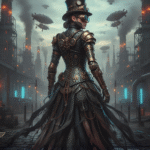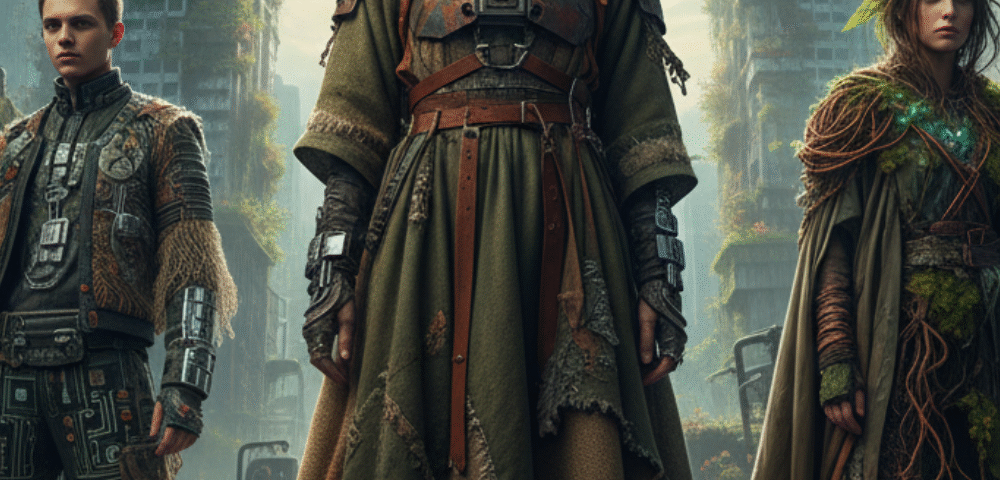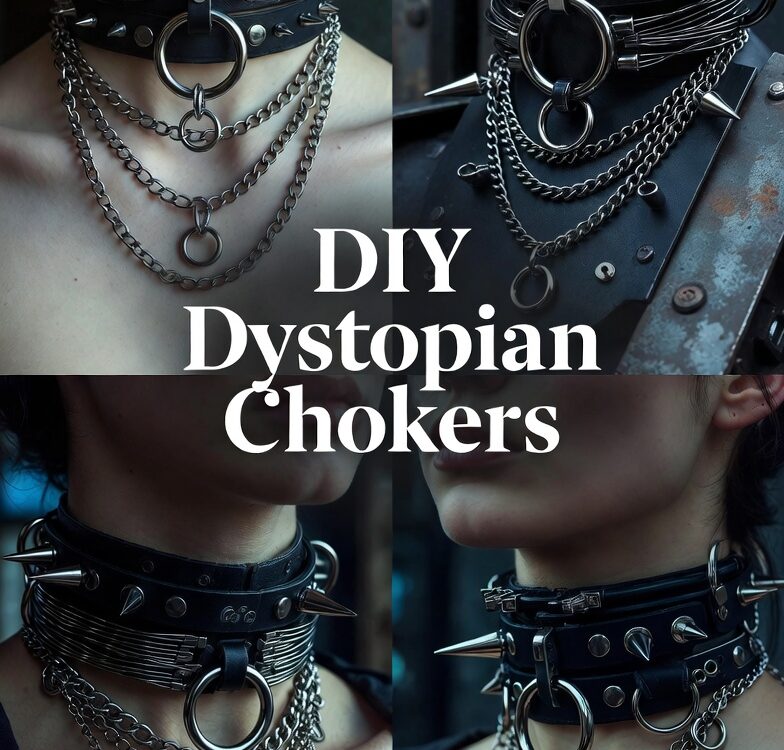
Gears of Oppression: Exploring the Steampunk Dystopian Mix
October 18, 2025
Punk Dystopian Fashion: Embracing Rebellion in a Futuristic World
October 19, 2025Fashion has always been a mirror, reflecting our hopes, fears, and the state of our world. Today, as conversations around climate change and environmental responsibility grow louder, a new and compelling aesthetic is emerging from the cultural consciousness: eco-dystopian fashion. This style is more than just a fleeting trend; it is a powerful commentary on our relationship with the planet, blending survivalist utility with a stark, weathered beauty. It imagines a future where resources are scarce, and clothing must be durable, repurposed, and deeply connected to the natural world.
This article will explore the growing movement of eco-dystopian fashion. We will unpack its core elements, from its earthy color palette to its focus on reclaimed materials. You will discover how this aesthetic is not just about a “look” but represents a deeper philosophy of sustainability, resilience, and conscious consumption. We will also examine its influences, from blockbuster films to the very real challenges facing our environment.
What is Eco-Dystopian Fashion?
Eco-dystopian fashion is a style subgenre that visualizes clothing in a post-apocalyptic or environmentally compromised world. It merges utilitarian design with a weathered, organic aesthetic, emphasizing sustainability, durability, and resourcefulness. Think of the rugged, functional garments you might see in films like Dune or Mad Max, but with a modern, eco-conscious twist.
At its heart, this style is a response to our current environmental anxieties. It asks a critical question: what will we wear when the world as we know it changes? The answer it provides is clothing that is built to last, made from what is available, and designed for survival. It rejects the fast-fashion cycle of disposable trends in favor of pieces that tell a story of resilience. Key characteristics include muted, earthy tones, heavy use of natural and recycled fabrics, modular designs, and a raw, unfinished feel.
The Core Aesthetics of an Eco-Dystopian Wardrobe
The visual language of eco-dystopian fashion is distinct and evocative. It combines practicality with a sense of poetic decay, creating a look that is both haunting and beautiful.
Color Palette: Hues of Survival
The colors of eco-dystopian fashion are pulled directly from the earth. Forget bright, synthetic neons; this palette is all about subtlety and camouflage.
- Earthy Tones: Shades of khaki, olive green, ochre, rust, and sand dominate. These colors evoke a sense of being grounded and connected to the natural landscape.
- Muted Grays and Blacks: Charcoal, slate, and faded black add a gritty, industrial edge, suggestive of urban decay and reclaimed machinery.
- Bleached and Sun-Faded Hues: Garments often look as though they have been exposed to the elements for years, with colors washed out by the sun and wind. This creates a lived-in, authentic feel.
Materials and Textures: The Fabric of a New World
Fabric choice is perhaps the most important element of eco-dystopian fashion. It’s not just about what a garment looks like, but what it’s made of and where it came from.
- Natural Fibers: Hardy materials like organic cotton, linen, hemp, and wool are staples. These fabrics are biodegradable, durable, and breathe well, making them practical for a world with unpredictable climates.
- Repurposed and Upcycled Materials: This is where the “eco” part truly shines. Old military surplus, discarded canvases, patched denim, and even unconventional materials like reclaimed rubber or plastics are given a new life. This practice speaks to a future where nothing is wasted.
- Raw and Unfinished Textures: Frayed edges, visible mending (sashiko stitching), and rough, unprocessed textures are celebrated. This aesthetic rejects the slick perfection of mass-produced clothing and embraces imperfection as a sign of history and resilience.
Silhouettes and Functionality: Dressed for the Unknown
The silhouettes in eco-dystopian fashion are driven by purpose. Every pocket, strap, and layer has a reason to exist.
- Layering and Modularity: Clothing is often designed to be layered, allowing the wearer to adapt to changing conditions. Vests are worn over long-sleeved shirts, and scarves or wraps can double as head coverings or filters. Modular pieces with detachable pockets or sleeves add to this versatility.
- Utilitarian Details: Cargo pockets, durable hardware like metal clasps and D-rings, and reinforced seams are common. The focus is on function over pure form, drawing inspiration from workwear and military gear.
- Asymmetry and Deconstruction: Garments often feature asymmetrical cuts and deconstructed elements, as if they have been pieced together from salvaged scraps. This creates a dynamic and visually interesting silhouette that breaks away from conventional tailoring.
The Philosophy Behind the Fashion
Eco-dystopian fashion is more than just an aesthetic; it is a movement with a powerful underlying philosophy. It challenges our consumption habits and encourages a more mindful approach to what we wear.
A Critique of Fast Fashion
This style stands in direct opposition to the fast-fashion industry, which is responsible for immense environmental damage and exploitative labor practices. By championing durable, timeless, and upcycled clothing, eco-dystopian fashion promotes a “buy less, choose well” mentality. It encourages wearers to invest in pieces that will last for years, not just a single season. The visible mending and weathered look celebrate the act of repairing and caring for our clothes, rather than discarding them.
Embracing Resilience and Resourcefulness
In a world facing resource scarcity, the ability to adapt and make do with what you have is a crucial skill. Eco-dystopian fashion embodies this spirit of resourcefulness. It celebrates the creativity of turning “waste” into something beautiful and functional. This DIY ethos empowers individuals to take control of their wardrobes, whether by learning to mend their own clothes, upcycling old garments, or supporting designers who use reclaimed materials.
Connecting with Nature
Despite its often-gritty appearance, this fashion trend fosters a deep connection with the natural world. The earthy color palette and use of natural fibers remind us of our dependence on the planet. The style suggests a life lived closer to the land, where one must be in tune with the seasons and the elements to survive. It is a form of wearable environmentalism, a daily reminder of the world we are trying to protect.
How to Incorporate Eco-Dystopian Fashion into Your Style
You don’t need to look like you’ve just stepped off a movie set to adopt elements of this trend. Integrating eco-dystopian fashion into your wardrobe can be a gradual and meaningful process.
- Start with the Palette: Begin by incorporating more earthy and neutral tones into your outfits. A khaki utility jacket, a pair of olive cargo pants, or a simple gray linen shirt can serve as a great foundation.
- Focus on Texture: Look for pieces with interesting textures. A chunky wool sweater, a pair of raw denim jeans, or a canvas tote bag can add a touch of ruggedness to any look.
- Prioritize Sustainable Brands: Seek out designers and brands that prioritize ethical production and sustainable materials. Many small, independent creators specialize in upcycled and natural-fiber clothing.
- Embrace Secondhand and DIY: Thrifting is a fantastic way to find unique, durable pieces that fit the eco-dystopian aesthetic. Learn basic mending skills to extend the life of your clothes and add a personal, patched-together touch.
- Accessorize with Purpose: Finish your look with functional accessories. A sturdy leather or canvas belt, a multi-pocket bag, or a pair of durable boots can tie everything together.
FAQs
Q: Is eco-dystopian fashion just a pessimistic trend?
A: While it draws from a “dystopian” future, the trend is fundamentally optimistic. It’s about resilience, creativity, and finding sustainable solutions in the face of challenges. It focuses on human ingenuity and our ability to adapt and thrive.
Q: How is this different from other styles like techwear or goth?
A: While there can be overlaps, the core focus is different. Techwear prioritizes futuristic technology and synthetic performance fabrics for an urban environment. Goth fashion often explores themes of romance and morbidity through a darker, more Victorian-inspired lens. Eco-dystopian fashion is uniquely defined by its emphasis on environmentalism, natural materials, and a weathered, survivalist aesthetic.
Q: Can I wear eco-dystopian fashion in a professional setting?
A: Absolutely. You can incorporate subtle elements. For example, a well-tailored blazer made from a high-quality linen or a pair of smart trousers in an olive or charcoal shade can align with the aesthetic while remaining office-appropriate. The key is to focus on quality materials and functional silhouettes rather than the more extreme, deconstructed looks.
Q: Where does the inspiration for eco-dystopian fashion come from?
A: Inspiration comes from a variety of sources. Films and TV shows like Dune, The Last of Us, and Mad Max are major visual influences. It also draws from real-world sources like military surplus clothing, traditional workwear, and the growing sustainable fashion and DIY communities.
Final Words
Eco-dystopian fashion is far more than a passing style. It is a thoughtful and relevant response to the world we live in today. It channels our collective anxieties about the future into a creative and proactive statement. By embracing durability over disposability, resourcefulness over waste, and a deep connection to the natural world, this aesthetic offers a blueprint for a more conscious way of dressing.
Whether you’re drawn to its rugged utility, its poetic, weathered look, or its underlying philosophy of sustainability, eco-dystopian fashion invites you to think more deeply about the clothes you wear. It reminds us that every garment has a story and that in a world of finite resources, the most stylish thing you can do is make it last.



